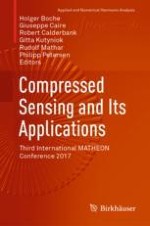The chapters in this volume highlight the state-of-the-art of compressed sensing and are based on talks given at the third international MATHEON conference on the same topic, held from December 4-8, 2017 at the Technical University in Berlin. In addition to methods in compressed sensing, chapters provide insights into cutting edge applications of deep learning in data science, highlighting the overlapping ideas and methods that connect the fields of compressed sensing and deep learning. Specific topics covered include:Quantized compressed sensingClassificationMachine learningOracle inequalitiesNon-convex optimizationImage reconstructionStatistical learning theoryThis volume will be a valuable resource for graduate students and researchers in the areas of mathematics, computer science, and engineering, as well as other applied scientists exploring potential applications of compressed sensing.
